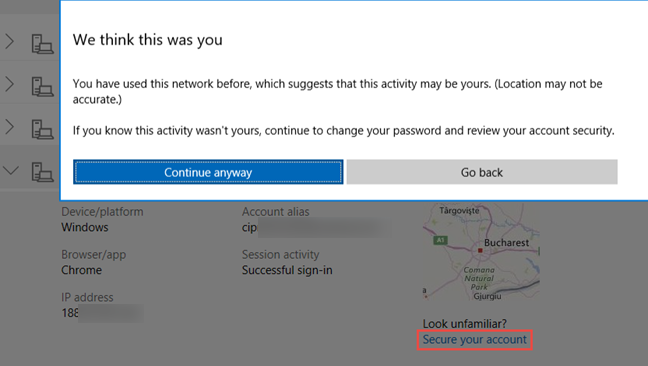
- MY MICROSOFT ACCOUNT HAS BEEN HACKED CRACKED
- MY MICROSOFT ACCOUNT HAS BEEN HACKED FULL
- MY MICROSOFT ACCOUNT HAS BEEN HACKED VERIFICATION
- MY MICROSOFT ACCOUNT HAS BEEN HACKED CODE
- MY MICROSOFT ACCOUNT HAS BEEN HACKED PASSWORD
MY MICROSOFT ACCOUNT HAS BEEN HACKED CODE
When it’s set up, you’ll get a text message with a code to enter every time you log in. To set up 2FA, you’ll need your smartphone on hand. Once it’s set up, you’ll get an alert any time someone tries to log in from an unknown device. Two-factor authentication, or 2FA, adds an extra layer of security to your email account. Set up two-factor authentication to protect yourself Now that you know what signs to look for, here’s what you need to do to take action against account intruders. You might need to reset your passwords again or lock them with a system like two-factor authentication. Leave no stone unturned, and write down anything you find for later. This is designed to prevent fraud and alerts you of an unauthorized login.įrom your inbox, search for terms like login, logged in or signed in. Many platforms will automatically send you an email when you log in from a different IP address than usual. The next thing you’ll need to look for is login alerts for accounts associated with your email address. If you see a location or device you don’t recognize, that’s cause for concern. Click Details underneath to see a list of access types (browser, mobile, POP3, etc.), IP address and date and time. In the bottom right corner, you’ll see Last account activity, followed by a time. To do this in Gmail, open your email account in a browser, then scroll to the bottom of your inbox. Some even show the browsers or devices used. Most email services let you check login activity, including the IP addresses or locations used to access your account. If you see an important email trashed that you wouldn’t have thrown away otherwise, your account may have been attacked. When you’re checking emails for signs of a threat, look in the trash and scan carefully for signs of disarray. This means you could lose important pieces of data that could clue you into what happened during the hack - including accounts they may have compromised. Not only do hackers rummage through your emails willy-nilly, but they’ll sometimes erase emails without thinking about the consequences.
MY MICROSOFT ACCOUNT HAS BEEN HACKED FULL
If you know your inbox was full of unopened messages that are now mysteriously marked as read, you may have a hacker on your hands.Ĭheck through as many read messages as you can, and make sure they don’t contain personal data before taking additional steps like resetting passwords. Read emails are usually presented in a standard, unbolded format, while unread messages are bolded. While they’re rummaging through your emails for personal data, they’re likely to open and close your messages arbitrarily. Did you actually read those emails?Įmail accounts typically let you sort through messages by read or unread status.īut if a hacker gets into your email address, all bets are off.
MY MICROSOFT ACCOUNT HAS BEEN HACKED PASSWORD
We’ll go over changing your password in greater detail below. Without doing this, the hacker could perform another reset after you’re done. If you see recent password changes for accounts you own, you’ll need to reset those passwords again on the other platforms before changing your email password. Look carefully through the messages that appear, and make a note of their date and time.
MY MICROSOFT ACCOUNT HAS BEEN HACKED VERIFICATION
To do this, search your inbox and use terms like password reset, password verification or password changed successfully. You need to make sure those passwords weren’t changed without your knowledge. Once they get inside, they can attempt to crack accounts associated with that email address. Did you actually change your passwords?Ī compromised email account is a golden ticket for any aspiring hacker. Your contacts may even reach out about receiving strange emails from you. If you don’t remember sending or composing emails with attachments, that’s as big of a red flag as you can find. It’s also worth checking your Sent and Drafts folders for messages with attachments, a primary vector for phishing malware. If you don’t remember sending those communications, that’s a key sign your account has been compromised. When you’re looking through sent mail, check the recipients, as well as when the emails were sent.
MY MICROSOFT ACCOUNT HAS BEEN HACKED CRACKED
More likely than not, their account was cracked open and their email address is being used as a spambot. This is the reason you’ll sometimes receive shady emails from contacts you know.

When your email gets hijacked by a hacker or malware, they’re often added to an arsenal of compromised accounts that further spread phishing campaigns. Using email accounts owned by real people bolsters a phishing campaign’s credibility.


If you’re worried your account has been hijacked, check your Sent and Drafts folders for emails you didn’t write.


 0 kommentar(er)
0 kommentar(er)
